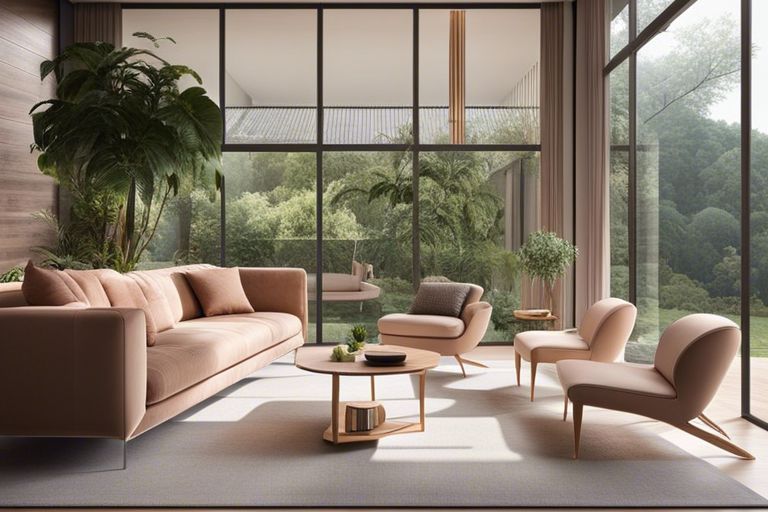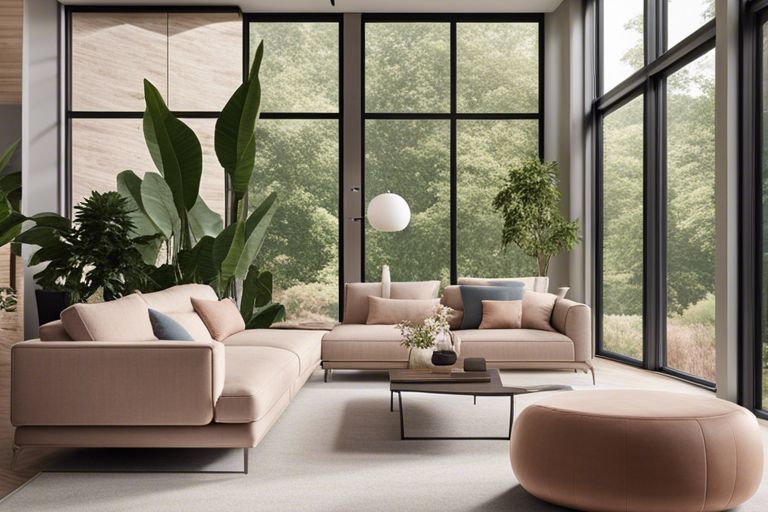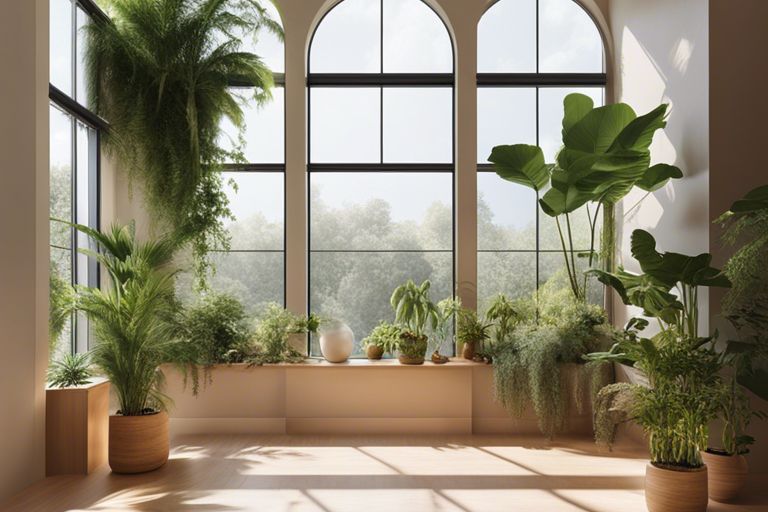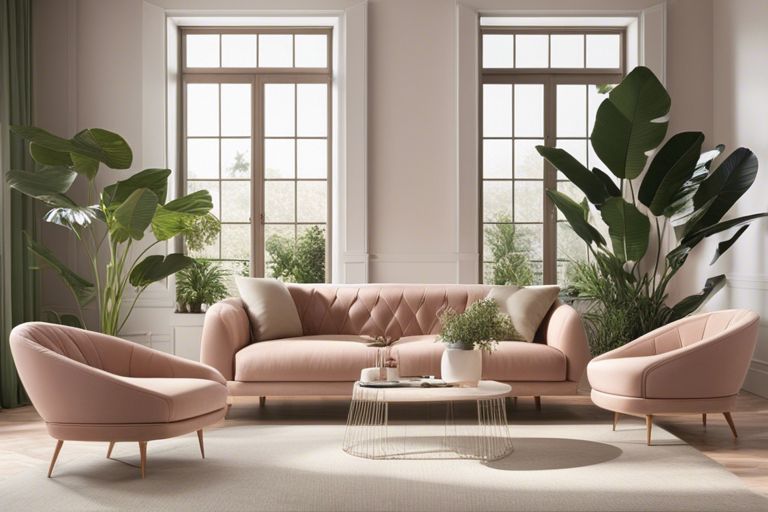Design. Are you curious about how to bring nature indoors through the art of biophilic design? By integrating natural elements into your living and working spaces, you can create a sense of harmony that promotes well-being and connects you with the outdoors. Discover the power of incorporating plants, natural light, and sustainable materials into your environment to enhance productivity and foster a sense of calm in your daily life. Let’s explore how you can achieve a balanced and harmonious living space with biophilic design techniques.

Key Takeaways:
- Biophilic design enhances well-being: Incorporating elements of nature into design can improve overall well-being by reducing stress, increasing productivity, and promoting a sense of calm.
- Connection to nature is crucial: Creating spaces that mimic natural environments or bring the outdoors inside can foster a deeper connection to nature, leading to improved mood and mental health.
- Design with purpose and intention: When implementing biophilic design principles, it is important to do so with a clear purpose and intentional placement of natural elements to create a harmonious and balanced environment.
Defining Biophilic Design
The Concept of Biophilia
Biophilic design is a concept that integrates nature and natural elements into the built environment to create a sense of well-being and harmony. The term ‘biophilia’ was first introduced by biologist Edward O. Wilson in the 1980s, referring to the innate human connection to nature. This design approach aims to satisfy our instinctual need to be connected to nature, ultimately promoting health, productivity, and overall happiness.
The Role of Nature in Design
Design plays a crucial role in implementing biophilic principles into spaces. By incorporating natural elements such as plants, water features, natural lighting, and organic materials, designers can create environments that mimic the natural world. This integration not only enhances the aesthetic appeal of a space but also has numerous positive effects on occupants, including reduced stress levels, improved cognitive function, and increased creativity.
Principles of Biophilic Design
There’s a set of principles that guide biophilic design, focusing on incorporating natural elements into the built environment to create a sense of harmony and well-being. By understanding and implementing these principles, you can transform your space into a sanctuary that reconnects you with nature.
Natural Light and Ventilation
Natural light and ventilation are necessary aspects of biophilic design. Maximizing natural light not only reduces the need for artificial lighting but also improves mood and productivity. Proper ventilation helps maintain a healthy indoor environment by reducing pollutants and enhancing air quality. By strategically placing windows and incorporating operable elements, you can optimize natural light and ventilation in your space.
Organic Forms and Shapes
With organic forms and shapes, biophilic design mimics nature’s curves, patterns, and symmetry. By incorporating these elements into your space, you can create a sense of tranquility and balance. Curved lines can evoke feelings of comfort and relaxation, while asymmetrical arrangements can add visual interest and depth to your environment.
Shapes found in nature, such as the spiral of a seashell or the branching of a tree, can inspire the design of furniture, fixtures, and architectural details. By embracing these organic forms, you can bring a sense of natural beauty and harmony into your space.
Material Selection and Sustainability
Organic materials play a crucial role in biophilic design, as they reflect the natural world and promote sustainability. Choosing materials like wood, stone, bamboo, and cork not only adds warmth and texture to your space but also reduces environmental impact. Sustainable practices such as using recycled or upcycled materials further enhance the eco-friendly aspect of biophilic design.
Biophilic design emphasizes the importance of selecting materials that support human well-being and the planet. By opting for sustainable materials and practices, you can contribute to a healthier environment while creating a space that nurtures your connection to nature.
Benefits of Biophilic Design
Improved Mental Health and Well-being
For those seeking to improve mental health and well-being, incorporating biophilic design principles into interior spaces can have a profound impact on your overall sense of harmony. With a focus on connecting with nature, Creating Harmony: Biophilic Design Principles in Interior Spaces can help reduce stress levels, boost mood, and increase feelings of relaxation and tranquility.
Increased Productivity and Focus
Improved productivity and focus are key components of a successful work environment. By incorporating biophilic design elements such as natural light, indoor plants, and views of nature, you can create a space that promotes a sense of well-being and improves your ability to concentrate and stay focused on tasks.
A clutter-free and well-organized workspace can also contribute to increased productivity. By decluttering your desk and incorporating natural materials such as wood and stone, you can create a calming environment that fosters efficiency and creativity.
Enhanced Creativity and Innovation
Creativity is imperative in many aspects of life, whether it’s problem-solving at work or expressing yourself through art. By integrating biophilic design elements into your living or working space, you can stimulate creativity and encourage innovative thinking. Natural elements such as water features, living walls, and natural textures can inspire new ideas and help you think outside the box.
Applications of Biophilic Design
Once again, let’s research into the various applications of biophilic design and how it can enhance different spaces in our lives.
Residential Spaces: Bringing Nature Indoors
Indoors, incorporating biophilic design elements such as natural light, indoor plants, and natural materials can help create a sense of serenity and connection to nature. Imagine walking into your living room and being greeted by an array of lush green plants, or waking up to sunlight streaming in through large windows. These simple additions can help improve your well-being and bring a touch of the outdoors into your everyday living space.
Commercial Spaces: Boosting Employee Morale
Morale in the workplace is crucial for productivity and employee satisfaction. By integrating biophilic design principles into office spaces, you can significantly boost employee morale and overall well-being. Natural elements such as green walls, water features, and views of nature can create a more harmonious and energizing work environment. Employees are likely to feel more inspired, motivated, and connected to their surroundings, leading to a more positive work culture.
Biophilic design in commercial spaces is not just a trend but a proven strategy to enhance employee performance and satisfaction. Studies have shown that employees working in environments with natural elements are more productive, creative, and experience lower levels of stress and absenteeism.
Public Spaces: Creating Community Hubs
Residential areas and public spaces can benefit greatly from biophilic design principles. Creating community hubs that incorporate elements of nature such as urban gardens, green spaces, and natural seating areas can bring people together and foster a sense of belonging. These spaces become not just places to pass through but destinations where people can connect with each other and with nature.
For instance, a neighborhood park designed with biophilic elements like natural landscaping, walking paths, and interactive installations can become a central gathering point for residents of all ages. It provides a retreat from the urban hustle and bustle, promotes physical and mental well-being, and strengthens bonds within the community.
Challenges and Limitations
Balancing Aesthetics and Functionality
The challenge you might face with biophilic design is finding the perfect balance between aesthetics and functionality. While nature-inspired elements can enhance the visual appeal of a space, they should also serve a purpose and improve the overall functionality of the environment. It is crucial that each biophilic design element not only looks good but also contributes to the well-being and productivity of the occupants.
Overcoming Budget Constraints
To overcome budget constraints in implementing biophilic design, you may need to get creative with sourcing materials and utilizing cost-effective alternatives. Any initial investment in biophilic design can lead to long-term benefits such as improved air quality, reduced stress levels, and increased productivity. By prioritizing key biophilic design elements that align with your budget, you can still create a harmonious and nature-inspired space without breaking the bank.
Understanding the long-term benefits of biophilic design can help justify the initial costs and convince stakeholders of the value it brings to the environment and its occupants.
Addressing Climate and Regional Considerations
Functionality plays a crucial role in addressing climate and regional considerations when implementing biophilic design. By choosing plant species that are native to the region, you can ensure easier maintenance and better adaptation to local climate conditions. Additionally, incorporating natural ventilation strategies can help regulate indoor temperatures and reduce energy consumption.
Plus, considering the orientation of the building and maximizing natural light exposure can further enhance the biophilic design elements and create a more sustainable and harmonious environment.
Best Practices and Tips
Many biophilic design elements can help you create a sense of harmony in your space. Here are some best practices and tips to guide you:
- Incorporating Plants and Green Walls: Adding nature to your indoor environment through plants and green walls can significantly enhance the biophilic experience. Choose a variety of plants with different shapes, sizes, and textures to create visual interest and improve air quality. Make sure to place them strategically near windows or light sources to thrive. Additionally, green walls can serve as a focal point while bringing a sense of the outdoors inside.
- Using Natural Materials and Textures: Incorporating natural materials like wood, stone, bamboo, or cork into your design can evoke a sense of warmth and connect you to the environment. Opt for organic textures and finishes that mimic those found in nature to create a cohesive and biophilic space that feels inviting and calming.
Incorporating Plants and Green Walls
Any biophilic design can benefit from the inclusion of plants and green walls. These elements not only add aesthetic appeal but also provide numerous health benefits, such as improved air quality and reduced stress levels. Integrating plants into your space is a simple yet effective way to enhance your well-being and create a harmonious environment. Thou,/p>
Using Natural Materials and Textures
An vital aspect of creating a biophilic design is the incorporation of natural materials and textures. By introducing elements like wood, stone, or clay, you can add warmth and authenticity to your space. Textures found in nature can evoke a sense of tranquility and create a more organic and timeless atmosphere.
Designing for Flexibility and Adaptability
With biophilic design, it is important to consider flexibility and adaptability in your space. By incorporating movable furniture, modular layouts, and versatile decor, you can easily adjust your environment to embrace changing needs and preferences. This approach allows you to create a dynamic and harmonious space that can evolve with you over time.
Summing up
To wrap up, implementing biophilic design in your space can significantly enhance your well-being and create a sense of harmony with nature. By incorporating natural elements, light, and greenery, you can improve your mood, productivity, and overall quality of life. Be mindful of, creating a harmonious environment through biophilic design is not only beneficial for you but also for the planet as it promotes sustainability and a deep connection with nature.
FAQ
Q: What is Biophilic Design?
A: Biophilic Design is an innovative approach to architecture and interior design that seeks to incorporate nature and natural elements into the built environment. It aims to create spaces that enhance our connection to nature, improve well-being, and create a sense of harmony.
Q: What are the benefits of Biophilic Design?
A: Biophilic Design has numerous benefits, including improved air quality, reduced stress levels, increased productivity, and overall well-being. By integrating elements such as natural light, plant life, and natural materials, spaces can become more inviting and inspiring.
How can I incorporate Biophilic Design into my space?
A: To incorporate Biophilic Design into your space, consider adding elements such as large windows for natural light, indoor plants for improved air quality, natural materials like wood and stone, and views of nature whenever possible. By bringing the outdoors in, you can create a sense of harmony and connection to nature in your environment.


